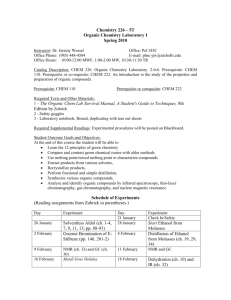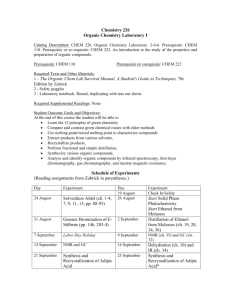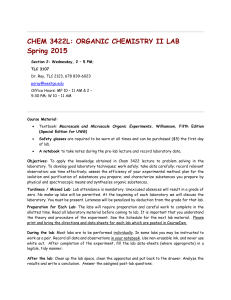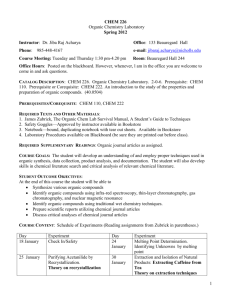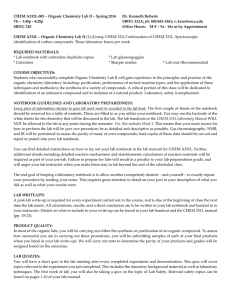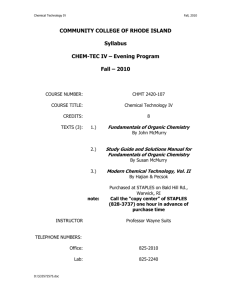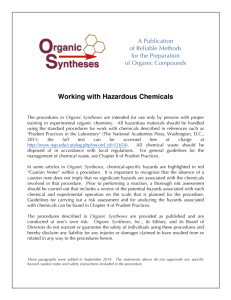Introductory Physical Science PHSC 102 3 credits Bea 238
advertisement
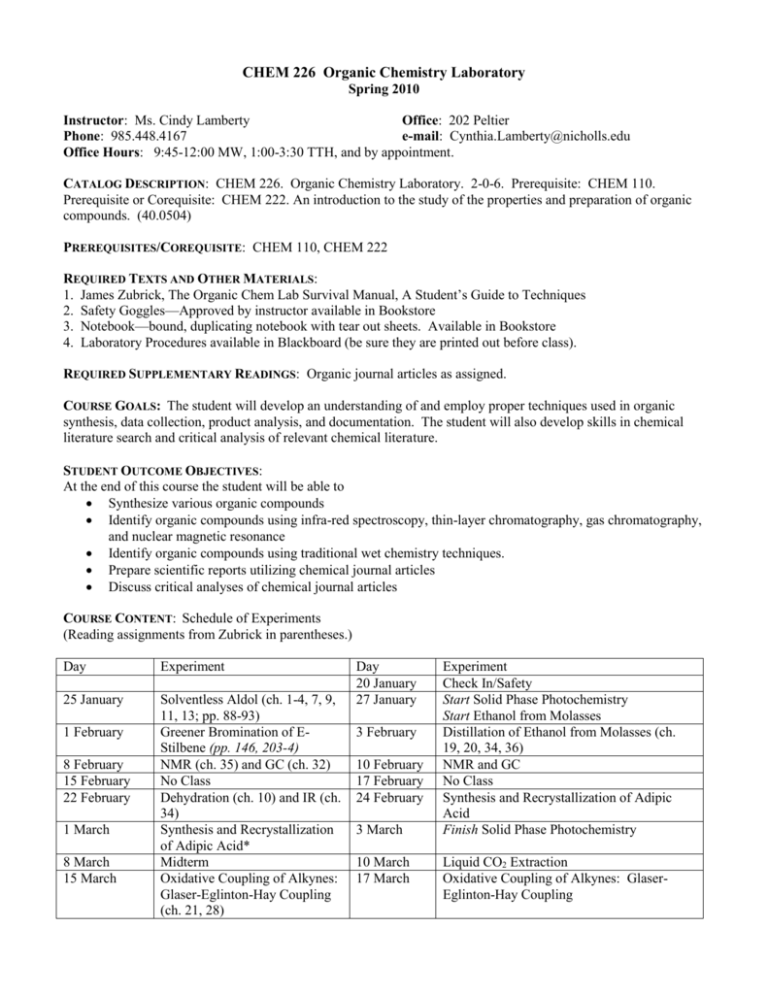
CHEM 226 Organic Chemistry Laboratory Spring 2010 Instructor: Ms. Cindy Lamberty Office: 202 Peltier Phone: 985.448.4167 e-mail: Cynthia.Lamberty@nicholls.edu Office Hours: 9:45-12:00 MW, 1:00-3:30 TTH, and by appointment. CATALOG DESCRIPTION: CHEM 226. Organic Chemistry Laboratory. 2-0-6. Prerequisite: CHEM 110. Prerequisite or Corequisite: CHEM 222. An introduction to the study of the properties and preparation of organic compounds. (40.0504) PREREQUISITES/COREQUISITE: CHEM 110, CHEM 222 REQUIRED TEXTS AND OTHER MATERIALS: 1. James Zubrick, The Organic Chem Lab Survival Manual, A Student’s Guide to Techniques 2. Safety Goggles—Approved by instructor available in Bookstore 3. Notebook—bound, duplicating notebook with tear out sheets. Available in Bookstore 4. Laboratory Procedures available in Blackboard (be sure they are printed out before class). REQUIRED SUPPLEMENTARY READINGS: Organic journal articles as assigned. COURSE GOALS: The student will develop an understanding of and employ proper techniques used in organic synthesis, data collection, product analysis, and documentation. The student will also develop skills in chemical literature search and critical analysis of relevant chemical literature. STUDENT OUTCOME OBJECTIVES: At the end of this course the student will be able to Synthesize various organic compounds Identify organic compounds using infra-red spectroscopy, thin-layer chromatography, gas chromatography, and nuclear magnetic resonance Identify organic compounds using traditional wet chemistry techniques. Prepare scientific reports utilizing chemical journal articles Discuss critical analyses of chemical journal articles COURSE CONTENT: Schedule of Experiments (Reading assignments from Zubrick in parentheses.) Day Experiment 25 January Solventless Aldol (ch. 1-4, 7, 9, 11, 13; pp. 88-93) Greener Bromination of EStilbene (pp. 146, 203-4) NMR (ch. 35) and GC (ch. 32) No Class Dehydration (ch. 10) and IR (ch. 34) Synthesis and Recrystallization of Adipic Acid* Midterm Oxidative Coupling of Alkynes: Glaser-Eglinton-Hay Coupling (ch. 21, 28) 1 February 8 February 15 February 22 February 1 March 8 March 15 March Day 20 January 27 January 3 February 10 February 17 February 24 February 3 March 10 March 17 March Experiment Check In/Safety Start Solid Phase Photochemistry Start Ethanol from Molasses Distillation of Ethanol from Molasses (ch. 19, 20, 34, 36) NMR and GC No Class Synthesis and Recrystallization of Adipic Acid Finish Solid Phase Photochemistry Liquid CO2 Extraction Oxidative Coupling of Alkynes: GlaserEglinton-Hay Coupling 22 March 29 March 5 April 12 April 19 April 26 April Friedel-Crafts Reaction: Acetylation of Ferrocene Electrophilic Aromatic Iodination No Class Microwave Synthesis of 5,10,15,20Tetraphenylporphyrin (ch. 29) Nucleophilic Substitution of Fabric Dyes1 Review 24 March 31 March Friedel-Crafts Reaction: Acetylation of Ferrocene* Biodiesel 7 April 14 April No Class Microwave Synthesis of 5,10,15,20Tetraphenylporphyrin 21 April Combinatorial Chemistry2 28 April Final Exam 3 May Course Content: 1freshly washed 100% cotton material or T-shirt required by each student 2 samples require 24 hours incubation so each student will be required to return the next day (not class day) to view the plates *Formal reports on adipic acid, acetylferrocene COURSE REQUIREMENTS: All students will perform all experiments using proper safety practices. Notebook: 20 points/experiment 15 experiments Formal report: 50 points/experiment 2 experiments Midterm Exam Final Exam METHOD OF EVALUATION: A straight percentage is used to determine grade. A = 90% B = 80% C = 65% 300 points 100 points 50 points 50 points D = 55% MAKE-UP POLICY: No make-ups are allowed for the experimental or discussion portion of the class. Late laboratory reports will be deducted 5 points per day (including weekends). ATTENDANCE POLICY: Attendance is mandatory. This is a laboratory class. You must be present to complete the requirements. If you miss one (1) laboratory with an excused absence I will recalculate grade. Unexcused absences result in a zero for that experiment. ACADEMIC HONESTY POLICY: Any student found cheating, including plagiarism, will be subject to the penalties as stated in the Student Code of Conduct handbook; including but not limited to a score of zero on exam, review or report, expulsion from the class or expulsion from the University. SEMESTER WITHDRAWALS : The last day to withdraw from the class with a “W” is Wednesday 31 March 2010. ACADEMIC DISABILITIES POLICY: If you have a documented disability that requires assistance, you will need to register with the Office of Disability Services for coordination of your academic accommodations. The Office of Disability Services is located in Peltier Hall, Room 100-A. The phone number is (985) 448-4430 (TDD 449-7002). ACADEMIC GRIEVANCES. The proper procedure for filing grade appeals or grievances related to academic matters is listed in Section 5 of the Code of Student Conduct and at he following link: http://www.nicholls.edu/documents/student_life/code_of_conduct.pdf . CONTINUED LEARNING FOLLOWING AN EXTREME EMERGENCY: In order to make continued learning possible following an extreme emergency, students are responsible for: reading regular emergency notifications on the NSU website; knowing their Blackboard (or designated system) student login and password; knowing how to use and access Blackboard (or university designated electronic delivery system); being familiar with emergency guidelines; evacuating textbooks and other course materials; contacting faculty regarding their intentions for completing the course. Faculty are responsible for: their development in the use of the Blackboard (or designated) software; having a plan for continuing their courses using only Blackboard and email; continuing their course in whatever way suits the completion of the course best, and being creative in the continuation of these courses; making adjustments or compensations to a student's progress in special programs with labs, clinical sequences or the like only in the immediate semester following the emergency. CLASS DISRUPTIONS: The use of cellular phones, pagers or any other electronic personal devices is prohibited in class. Any infractions will result in class being dismissed and experiments considered over. This includes but not limited to using your phone as timer—get a watch or I will supply stopwatches if needed, going to the hallway while a experiment is ongoing to check on texts. texting or calling or receiving incoming calls or texts receiving alerts regarding incoming texts or calls using phone as alarm system. NOTEBOOK Notebooks must be written legibly to avoid loss of points. Prelab Due before beginning the experiment. TITLE DATE PURPOSE Describe what is expected of the laboratory. This should be only one or two sentences, in your own words--do not copy from the manuals. PROCEDURE A flow diagram is best. Abbreviated version of what you will be doing. Read the lab and be familiar with what will be happening. Summarize the steps. DATA TABLE Listing of all of the reagents and solvents used in the experiment. List in table form only. mass used reagent or molecular moles used melting boiling solubility in or density product weight or produced point point solvents used. produced CHEMICAL EQUATIONS Write all of the major chemical reactions and side reactions for the experiment. Include the amounts called for in the experiment (which is the limiting reagent?) and the theoretical yield. Not necessary for the distillation, melting point, or crystallization experiments. You may not begin the experiment until the prelab section is completed and checked by instructor. Postlab OBSERVATIONS All data and everything that occurs in lab as it happens. Colors, smells, amounts used, mixing, temperatures, apparatus used, time for reaction, spills if they occur etc. Draw pictures if appropriate, use tables, graphs, equations, etc. Record details such as Instrument name and maker, model number and serial number, chemical manufacturer, grade, lot number, expiration date, etc. This section cannot be too long. Spectra are also to be included with this section. Due at the end of lab. CALCULATIONS Theoretical yield, Percent Yield, Atom Economy, Economical Analysis POST LAB QUESTIONS: Answer the post lab questions that are listed at the end of each experiment.
